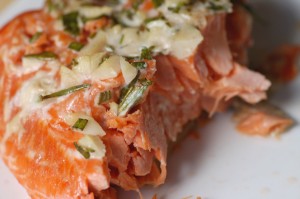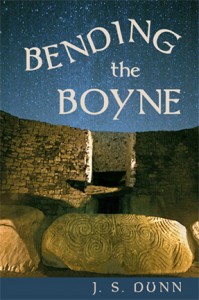If you’re reading this post before lunch, be prepared to work up an appetite–or at least a very strong craving for salmon! Today J.S. Dunn is here to talk about what a winter solstice feast would have been like in ancient Ireland. I’m fascinated by this for several reasons, but not the least of which is that I’d been led to believe that the ancient Romans and Greeks didn’t use butter, using olive oil instead. If the ancient Irish were using butter, I wonder what accounts for this difference in ancient culture? Read on for a delicious recipe on a Juniper Reduction!
WINTER SOLSTICE FEAST AT THE BOYNE, 2200 BCE, the great Boyne passage mounds.
Food is important in Bending The Boyne for a number of reasons. Ireland separated from the Continent earlier than Big East (the UK’s isle) hence it has relatively fewer flora and fauna species for its food chain. Add to that Eire’s capricious weather, and even as of the 1840s the climate + food supply was a recipe for disaster: Famine with a capital F.

What did the ancient Irish eat at 4,200 years ago? And, what about the peoples in what is now Portugal/Spain, the Costa Verde, and up the Bay of Biscay to the Loire/Morbihan coast? At first, researching prehistoric foods for this tale looked daunting.
The Dindshenchas, the medieval text that provided myth fragments for Bending The Boyne, has clues to the early diet: the sacred salmon of knowledge, the hazelnut which also imparts wisdom, cereal grains for porridge, and various berries. The ancients used milk and butter from their herd animals. To this day, well-made oak casks holding Bronze Age butter turn up at digs in the bogs.
Domestic meats of sheep and cattle, and cuts of wild deer and boar, show in the bone counts from archaeological digs. Fish were trapped in wattle river weirs long before 2200 BCE, and shellfish consumed in coastal regions per remains in ancient shell middens.
An ancient prohibition on killing swans, a geis, provided material for the plot. There is evidence that swans were indeed eaten for food, and swans winter at the river Boyne in great numbers. The prohibition re: swans was perhaps politically motivated—this novel shows a plausible reason for that geis.
The ancients’ knowledge of edible seeds, roots, and herbs would far exceed our own based on paleobotany surveys at excavations. They collected and dried the wild apple in the Isles, and berries.
In warmer latitudes like ancient Spain the Bronze Age people began to cultivate the olive and other fruiting shrubs. There is evidence they knew which acorns to collect, and ground those into flour. Spain’s meltingly tender acorn-fed ham shows up in this novel, for that may have begun in antiquity given their early use of abundant acorns.
Ultimately many passages about food became a joy to write to show the richness of the environment for those who well knew how to utilize it. For these ancients, a feast probably was literally a sacrament of life. The reborn winter solstice sun showed the ancients that spring’s bounty would return.

Boyne solstice feast:
- Smoked salmon, smoked haddock
- Dried apples stewed with fresh or dried swan
- Wild boar, venison, joint of beef ; boiled or roasted
- Meal cakes of finely ground hazelnuts, seeds, and grains, sweetened with honey
- Soft white cheese, sweet butter
- Mead* and herbal infusions
* “Mead distilled sparkling, its praise is everywhere.”
From Welsh myth, Song to Mead
Juniper reduction sauce for modern roast wild game:
Here is a simple (and relatively low-fat) reduction sauce if you happen to be serving wild boar or venison for winter solstice or a more modern holiday. Juniper berries impart a flavor like rosemary with a citrus hint. The berries should be dried and crushed before use. Note, buy in a shop—don’t try to harvest your own; some juniper varieties are toxic.
Roast or sauté the meat, keep warm. Deglaze the pan with around ½ cup of red wine (or Calvados, or Guinness, or whatever!), and simmer that mixture in a heavy saucepan until the essence reduces by half in volume. The sauce should coat a spoon. Add one chopped shallot ( or wild garlic shoots if you have those at hand ) and 8 fluid ounces of beef consommé ( not bouillon) and reduce again. If desired, butter (3 tbsp) can be added for a smoother, shiny sauce or to correct overcooking! Add the crushed juniper berries when almost ready to serve the sauce. 4-6 portions.
Thanks for having me!
About The Author
J.S. Dunn lived in Ireland during the past decade, on 12 lovely acres fronting a salmon river. From there, the author researched and traveled the Atlantic coasts of Wales, Brittany, and Spain, while completing Bending The Boyne.
Bending The Boyne reflects the new paradigm that Gaelic culture and Gaelic language arose in the early Bronze Age rather than the Iron Age. See also the works of William O’Brien, PhD, and Barry Cunliffe, PhD, archaeologists; and John Koch, linguist; eg, Celtic From The West (2010, Oxford Press).
Website: www.jsdunnbooks.com
Blog/updates via FB Wall: http://www.facebook.com/pages/Bending-The-Boyne/192198197473429#!/pages/Bending-The-Boyne/192198197473429
Amazon: http://www.amazon.com/Bending-Boyne-Novel-Ancient-Ireland/dp/0983155410/ print 350 pp, and Kindle/app version
B&N: http://www.barnesandnoble.com/w/bending-the-boyne-j-s-dunn/1102828874 print 350 pp, and Nook/app version


Interesting! I didn’t know either about butter being around that long ago. Very neat that casks of butter turn up at Bronze Age bog digs!
It makes me think that what we think we know about the ancient Romans and Greeks and Egyptians might be wrong too. A recent article suggests that the ancient Greeks traded in ginger–something that surprised a lot of folks who had assumed a more limited number of trading spices and foods available at the time. So did the ancient Irish invent butter or did the other ancient people have it as well?
I recently went down the rabbit hole on yogurt. Pliny the Elder talks about yogurt; it’s the first mention of it that we know of and he talks of it as something nomads make, as if it weren’t part of the normal cuisine.
Anyone else know anything about ancient dairy products?
Butter is not included in any extant Roman recipes, but there aren’t that many extant recipes. From my research, I think Italian Romans most likely didn’t use butter (maybe due to spoilage issues?), but those in the provinces certainly might have if they tasted it and liked it, just like we adopt “foreign” ingredients into American food.
Spoilage is an interesting factor. One presumes the climate in ancient Ireland may have been more hospitable to keeping butter fresh…
Just what I was going to say. It would have been before pasteurization and refrigeration, in a warm climate.
I wonder if the types of dairy animals in various cultures also played a role? I have no idea if all kinds of milk makes a good butter.
Ehmm. Apparently the ancients, wherever they lived, milked whatever they could and including horses. But let’s not even think about butter made from horses’ milk! Probably by 400 BCE in Roman times the oil yield from olives was such that it effectively served a role like butter.
Now for the truly nerdly response from archaeogenetics : the genetics of dairy herds and human lactose tolerance can be mapped. Predictably, the trend toward dairying with bovines overlaps on the map with areas where northern Europeans developed lactose tolerance—and to a greater degree in the population than in southern Europe where dairying has not been as prevalent probably due to difference in climate. We all know there are some persons today who remain lactose INtolerant. (Just as some percentage of the modern population cannot properly digest cereals, also an indicator of the neolithic change in eating habits. Not everyone mutated and the subgroup which cannot digest cereals shows a higher incidence of diabetes. ) So in more ways than one, you are what you eat.
Here is a link to a 2011 news article re: a bog butter cask, see http://www.freerepublic.com/focus/chat/2718130/posts . ….Your man who found it says he wasn’t much interested in having a sample…..
This is fascinating stuff.
You can go horribly wrong with this kind of post, there is not, nor ever was, any such thing as the “UK’s isle”. The modern construct of a sovereign entity of the United Kingdom encompasses many islands (including the northern portion of the island of Ireland).
I think the term you are seeking is Great Britain which defines the largest island of the British Isles. Careless talk costs lives! 😉
@ Charlie Farrow, not sure where you are going with that but this wasn’t a political post. It’s about food. The only life-threatening aspect is if someone were to pick their own juniper berries, or eat some Bronze Age butter as by now it’s gone off.
Other than that, there is no point to further confusing many if not most Yanks with the term, British Isles. The Republic Of Ireland is not part of the “British Isles” and has not been for decades. Enough lives have been lost already.
But thanks for posting and I sincerely hope you enjoy the solstice. *slan*
Just trying to inform.
http://en.wikipedia.org/wiki/British_Isles
This will help clarify as well.
http://en.wikipedia.org/wiki/Terminology_of_the_British_Isles
I had no idea that you could cook with juniper berries!